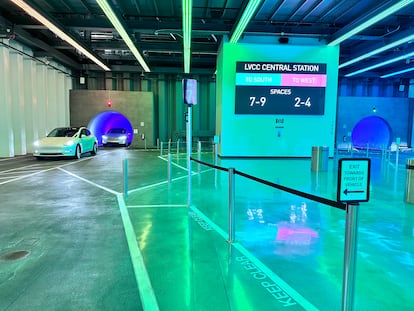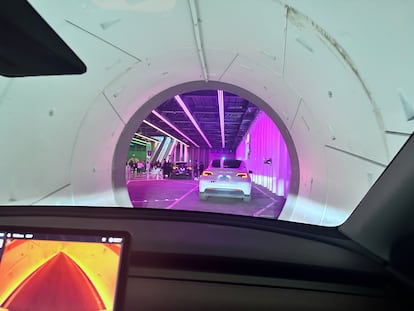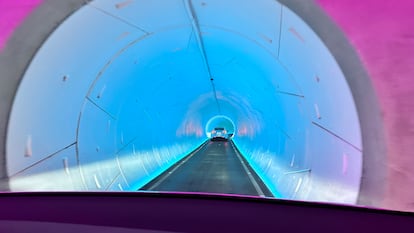The underground tunnels that Elon Musk says will end traffic jams
In Las Vegas, congestion means that cars are forced to move along at a snail’s pace. The Tesla CEO wants to change the status quo, with special routes for electric vehicles
Unsurprisingly, some of Elon Musk’s craziest ideas got started on Twitter: “The traffic is driving me crazy. I’m going to build a tunnel boring machine and start digging.”
The Tesla CEO tweeted this out in December 2016. This is how The Boring Company was established, with the objective of building underground tunnels to end traffic jams in big cities, such as Los Angeles. But six years later, the only tunnels open to the public run only about 1.7 miles long, beneath the Las Vegas Convention Center.
The system – called the LVCC Loop – is only operational when massive conventions take place in the state of Nevada. In total, the system has three stations: two on the surface and one underground. While trips are free at the moment, several employees consulted by EL PAÍS do not rule out that, in the future, there will be a cost to using the tunnel.
At the LVCC West Station, music plays in the background. Several workers wearing fluorescent yellow vests give directions to attendees of an electronics conference.
“It’s only possible to go to Central Station – South Station is closed today,” one of the workers notes, without going into further detail. He then tells the attendees where they can line up to wait for a car. If someone is travelling alone, it’s possible that other passengers will be allowed to accompany them in the back seat.
Every few seconds, new vehicles pull up at the station. They come out of a tunnel – all the cars are white, black and grey Teslas.

Most drivers wear earpieces – some also wear caps that read “Vegas loop.” They kindly greet passengers and confirm their destination.
“I’m going to save you half-a-mile on foot in about 30 seconds,” says Bryan, an American driver who has worked for The Boring Company since June 2022. According to Google Maps, the route between LVCC’s West and Central stations is about a 10-minute walk.
Bryan says that his job is wonderful: “I meet lots of people and drive a car that costs tens of thousands of dollars… plus, it’s exciting to be part of something new.”
From the LVCC West Station, the Tesla takes you down a hill and into a circular tunnel. The route – which is mostly straight, except for a few slight curves – is very short.
In 2018, Musk predicted that, in the near future, cars would circulate through the tunnel at a speed of 150 miles per hour. But in the test rides carried out by EL PAÍS, the maximum speed was a mere 36 miles per hour.
Strips of lights that change color line the walls, adding a futuristic touch to the experience. Sometimes, you catch a glimpse of other cars up ahead. These tunnels – which were built in about a year with boring machines – cost about $47 million, according to The Boring Company. When driving through them, there is hardly any space on the sides.
Alberto Núñez – a Mexican national who has been driving these cars for six months – explains that, in an emergency, any car can be removed in five minutes. “Traffic will never stop,” he emphasizes.
While driving, Núñez takes a look at a large screen on the dashboard. The images captured by the cameras – which are everywhere – indicate what’s going on outside, what speed the car is going at, if visibility is reduced, and even if passengers are wearing their seatbelts.
For Núñez, the main advantage of expanding these tunnels through Las Vegas or other cities is that traffic would be avoided on busy streets, such as the Strip.

It remains to be seen if Musk can manage to build these tunnels in other cities. So far, according to various media reports, proposed projects in Los Angeles, Chicago and Baltimore have been abandoned. And the Las Vegas LVCC system is still quite different from how Musk originally envisioned it. In 2018, the Tesla CEO claimed that the cars would be equipped with special wheels that would be adapted to the tunnel rails, but that idea also seems to have been scrapped.
Furthermore, when Musk presented a prototype of these tunnels in Los Angeles, he assured the public that only self-driving electric vehicles would use them. But in Las Vegas, every Tesla has a driver. However, Núñez predicts that “one day, you’ll leave the airport and a car with no one inside will take you wherever you need to go.”
“I guess not having drivers would make the service cheaper, because having us here is a big expense,” Bryan admits.
The LVCC Loop opened in 2021. According to The Boring Company, it has been in operation whenever a large convention has been held above. At SEMA 2021 – a car show – the system transported “between 24,000 and 26,000 passengers per day.”
Last year, at CES – one of the largest electronics conventions in the world – it was used by “between 14,000 and 17,000 people each day, with an average travel time of less than two minutes and a wait time of less than 15 seconds.” In 2021, Steve Hill – president of the Las Vegas Convention and Visitors Authority (LVCVA) – tweeted that the system could carry about 4,400 passengers per hour.
John Merrill – a resident of Indiana, who is attending this year’s CES conference – has travelled through these underground tunnels in a Tesla Model 3.
“It’s a nice little tunnel system. I think it would work in other cities, like Barcelona,” he says.
For Eddie Avila, from Honduras, “the only advantage is that you don’t have to walk and it’s fast.” But since he likes to walk, he would find this system better for other purposes. “The traffic sucks… it would be useful for us to go to the airport.”
Yeji Kim – who has flown in from South Korea to attend the electronics fair – points out that it’s “faster to go through these tunnels than to go by road, since there are no hotels or traffic lights in between.”
None of the tunnel users EL PAÍS spoke to could find any downsides with the free system. This newspaper tried to get in touch with The Boring Company regarding future projects and fees, but received no response.
Sign up for our weekly newsletter to get more English-language news coverage from EL PAÍS USA Edition
Tu suscripción se está usando en otro dispositivo
¿Quieres añadir otro usuario a tu suscripción?
Si continúas leyendo en este dispositivo, no se podrá leer en el otro.
FlechaTu suscripción se está usando en otro dispositivo y solo puedes acceder a EL PAÍS desde un dispositivo a la vez.
Si quieres compartir tu cuenta, cambia tu suscripción a la modalidad Premium, así podrás añadir otro usuario. Cada uno accederá con su propia cuenta de email, lo que os permitirá personalizar vuestra experiencia en EL PAÍS.
¿Tienes una suscripción de empresa? Accede aquí para contratar más cuentas.
En el caso de no saber quién está usando tu cuenta, te recomendamos cambiar tu contraseña aquí.
Si decides continuar compartiendo tu cuenta, este mensaje se mostrará en tu dispositivo y en el de la otra persona que está usando tu cuenta de forma indefinida, afectando a tu experiencia de lectura. Puedes consultar aquí los términos y condiciones de la suscripción digital.
More information
Archived In
Últimas noticias
Most viewed
- Reinhard Genzel, Nobel laureate in physics: ‘One-minute videos will never give you the truth’
- Oona Chaplin: ‘I told James Cameron that I was living in a treehouse and starting a permaculture project with a friend’
- Pablo Escobar’s hippos: A serious environmental problem, 40 years on
- Why we lost the habit of sleeping in two segments and how that changed our sense of time
- Chevy Chase, the beloved comedian who was a monster off camera: ‘Not everyone hated him, just the people who’ve worked with him’












































